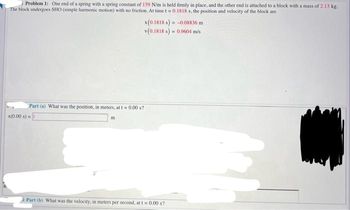Question
Needs Complete typed solution with 100 % accuracy.

Transcribed Image Text:Problem 1: One end of a spring with a spring constant of 159 N/m is held firmly in place, and the other end is attached to a block with a mass of 2.13 kg.
The block undergoes SHO (simple harmonic motion) with no friction. At time t= 0.1818 s, the position and velocity of the block are
Part (a) What was the position, in meters, at t= 0.00 s?
x(0.00 s) = 1
m
x(0.1818 s) = -0.08836 m
v(0.1818 s) = 0.9604 m/s
Part (b) What was the velocity, in meters per second, at t = 0.00 s?
Expert Solution
This question has been solved!
Explore an expertly crafted, step-by-step solution for a thorough understanding of key concepts.
This is a popular solution
Trending nowThis is a popular solution!
Step by stepSolved in 3 steps with 2 images

Knowledge Booster
Similar questions
- Suppose the mass of ice, 13 g, is measured with a scale that measures to 0.1 g. Calculate the percent precision (%) of the measured mass of the ice.arrow_forwardIf one variable increases in value and the other variable increases in value, the variables have a(n) ________ relationship.arrow_forwardIf n=5, how many values are possible for Ml?arrow_forward
- so b= 6.09 s^-2 but you used 5.21. when I plug in the answers its wrong, can you please fix this.arrow_forwardPLEASE CONSIDER THE TOLERANCE. DONT GIVE ME SCIENTIFIC NOTATIONSarrow_forwardA good-quality measuring tape can be off by 0.58 cm over a distance of 23 m.What is its percent uncertainty?arrow_forward
- A scanning electron micrograph of xylem vessels in a corn root shows the vessels magnified by a factor of 608. In the micrograph the xylem vessel is 5.60 cm in diameter. What is the diameter of the vessel itself, answer in cm? and By what factor has the cross-sectional area of the vessel been increased in the micrograph?arrow_forwardPls consider the given significant digitarrow_forwardThe tolerance is ± 1 in the 3rd significant digit.arrow_forward
arrow_back_ios
SEE MORE QUESTIONS
arrow_forward_ios